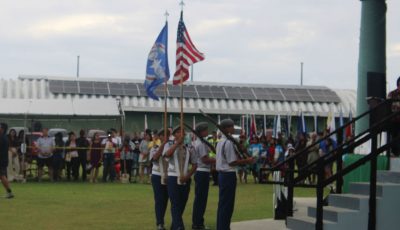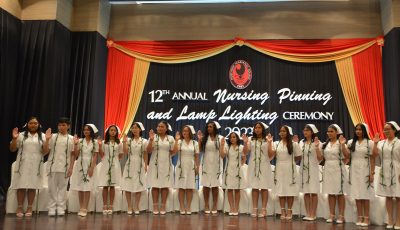Okeanos Marianas arrives
After an epic journey of 4,022 miles from Auckland, New Zealand, and guided only by the stars, the double-hulled Okeanos Marianas finally arrived on Saipan yesterday morning and was met by a platoon of dancers, dignitaries, island officials, and people who want to revive the navigating culture of the islands.
At approximately 8:30am, the eight-person Okeanos Marianas vessel pulled into the Susupe shore by the Guma Sakman near the Civic Center in Susupe and were met with a traditional ceremony participated in by Marianas High School students and greeted by family and friends of a few of the crew members.
The ceremony paid tribute to both the arrival of the vessel and the revival of ocean voyaging and traditional sea navigation. Okeanos Marianas is being eyed as a sustainable means of transport from Saipan to neighboring islands in the Northern Islands.
Emma Perez, Okeanos Sustainable Sea Transport Ltd. managing director, put together a heartfelt ceremony to honor the vessel, while also honoring master navigators Peia Patai, Tonie Piailug, and Sesario Sewralur for sharing the gift of ocean voyaging with the Marianas.
The ceremony also celebrated the safe voyage of the crew aboard the Okeanos Marianas. The crew included Steven Tawake from Fiji, Maurai Villa from France, India Tabellini from Italy, Deirdre Golani from the United States, and John Sablan, Devin Noison, and Andrea Carr of the Northern Marianas.
A visibly overwhelmed Perez said she was moved to tears upon her realization that the Okeanos Marianas had finally arrived on Saipan after awaiting its arrival for so long.
According to Perez, the Okeanos Marianas will change the lives of the people of the Marianas.
L.J. Castro, chairman of the Saipan and Northern Islands Municipal Council and an advocate of the indigenous culture, said the arrival of the Okeanos Marianas means a great deal to the Marianas.
“It’s a very significant canoe arrival because of the purpose of the vessel. It’s going to benefit the education of our youth and our people about traditional seafaring but also it’s going to help in assisting our residents of the Northern Islands,” said Castro.
Carr, who joined the voyage, left for New Zealand late last August to assist in the construction of the canoe. According to her, the voyage was intense at times due to the unpredictability of nature. “As long as we respect the ocean and the sky, we’ll be okay. …It was a great experience,” she said.
One of Carr’s biggest takeaways from being a part of the 4,000-mile voyage was that becoming an ocean navigator requires quick thinking.
“[Patai] made some spur-of-the-moment decisions which I really appreciated because without those decisions, we could have been in danger. My takeaway was to always listen and be mindful of what’s going on around you,” said Carr.
Patai said the biggest challenge he and his crew faced in their 40-day voyage to the Marianas was the weather condition slowing them down.
“We tried our best to be here. [We’re] a couple of days late but its okay because everyone is fine and safe,” he said.
One of Patai’s personal challenges was getting accustomed to his new crew. “It was tough, especially working with different cultures,” he said.
According to Patai, the shared bond they each had with the ocean helped, especially while teaching them the ways of seafaring. “North and south, it does not matter. We are people of the oceans and it makes it easy to teach them how to sail,” Patai said.



























